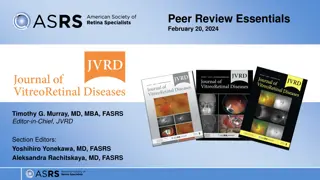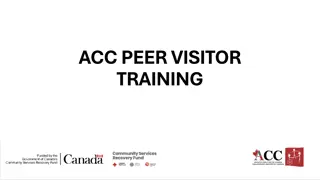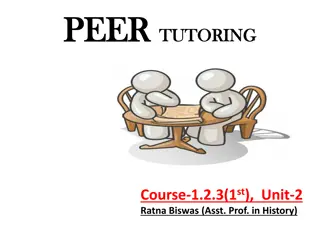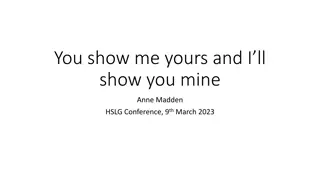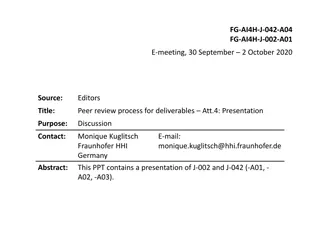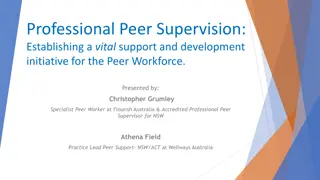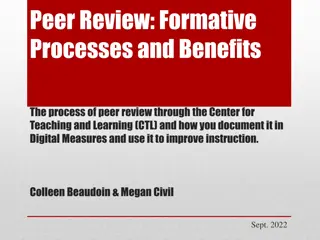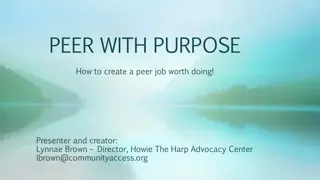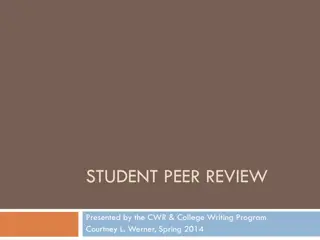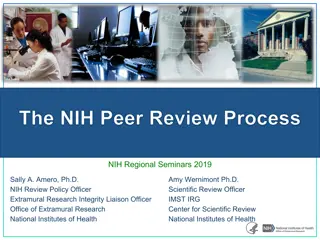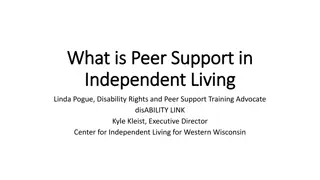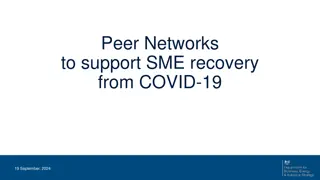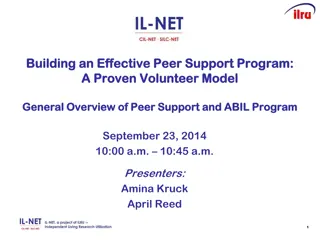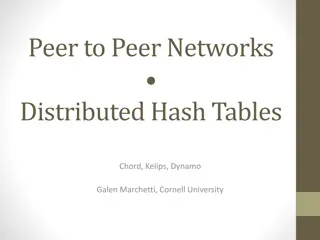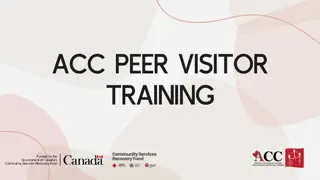Navigating Peer Review for Publication Success
Understanding the importance of peer-reviewed publications, this guide emphasizes selecting the right journal, submission strategies, and considerations like readership, openness to review, and submission terms. It provides insights into enhancing visibility, credibility, and quality control in scholarly work.
Download Presentation

Please find below an Image/Link to download the presentation.
The content on the website is provided AS IS for your information and personal use only. It may not be sold, licensed, or shared on other websites without obtaining consent from the author. Download presentation by click this link. If you encounter any issues during the download, it is possible that the publisher has removed the file from their server.
E N D
Presentation Transcript
Navigating Peer Review Chris Barrett STAARS/STAAARS+ program training November 17, 2022
Motivation Why is peer reviewed publication important? 1. Credentialing Employers, grantsmakers, others look at pub records. 2. Dissemination Grey literature research results are often hard to find, and even if findable often excluded from reviews. Peer reviewed publication helps researchers reach readers. 3. Quality control Especially if you do applied research, and want non- specialists to use your findings, you want experts to check your work. Peer review offers the best method to do so. So subject all of your research to peer review and aim to publish it all. Keep these three purposes in mind!
Step 1: Target journal(s) As paper takes shape, identify a target journal(s). 1. What journals published the papers you cite? - Join literature thread revealed editorial preference, established pool of reviewers, added visibility - Ensure you search those journals for relevant papers (since those authors are likely reviewers) 2. Any upcoming special issues that fit your topic? - Monitor blogs, Twitter, etc. - Build a network and get out to present your work - Can heighten visibility of your work
Step 1: Target journal(s) 3. What is the right journal level to pitch? - What readership should be interested? Discipline, multi- disciplinary, or sub-discipline audience? - How original is the work? - How rigorous and important are the findings? 4. When to submit to a reach journal? - You have generalizable findings (theory, methods, or empirics of quite general interest + compelling evidence). - Journal has a new editor with an interest in the area. - You can afford the time for an extra expected rejection.
Step 1: Target journal(s) 5. Are you willing to review regularly for the journal? - Past and prospective authors are the natural reviewer pool. You enter an implicit social contract by submitting. 6. Are you obliged (or want) to publish open access? - Check cost to ensure you can afford it or check with grants agency if they will support it directly (BMGF does). 7. Know terms of submission: are they ok for you? - Is there a submission or publication fee? - Is there an obligation to submit data and code for replication purposes? - If not feasible (e.g., using restricted access data), report that at time of submission.
Step 2: Submission Your masterpiece is ready! 1. When to submit? - Usually take time to present at conferences, especially at longer seminars where people can poke holes in it. - Send paper to friends/authors in the space for feedback (short email w/ title/abstract and link/attachment). Do not expect replies. And be sure to reciprocate! - Revise based on the feedback. Once you are getting no substantive new comments not yet addressed, submit. - Exception: when others are working on same topic and you are in a race to publish, submit earlier.
Step 2: Submission 2. Check for plagiarism and reproducibility - Most journals use an online plagiarism detection tool (iThenticate, etc.). Run your paper through a utility to check that you aren t inadvertently reproducing others text without due credit. That can happen inadvertently (e.g., poor notetaking, using material prepared by a co- author or RA who is unaware or unscrupulous, etc.). If you find a problem, fix it before submitting! (Don t worry about your own past versions the utility finds online.) - If a friend, colleague or service within your institution will take your code and data to verify the reproducibility of your empirical results, take advantage of that service. Nothing is more embarrassing or career-damaging than violations of academic integrity ... willful or inadvertent.
Step 2: Submission 3. Resolve any uncertainty about authorship - Collaborators should discuss co-authorship who is and is not a co-author? What is the ordering among you? and adhere to the Committee on Publication Ethics (COPE) guidelines to define who earned co-authorship. - Individuals who earned coauthorship must then consent to being named a coauthor. Both are necessary. - Develop a CRediT (Contributor Roles Taxonomy) statement to recognize individual contributions. Co-authorship disputes are damaging and hard to resolve post-submission.
Step 2: Submission 4. How/what to submit? - Go to target journal website and find Guide for Authors (or similar). Make sure you comply w/all rules: - Types of contributions (deception in experiments?) - Open access (and associated fees)? - Length (e.g., PNAS, Science, Nature) - Add a short cover letter: - Explain WHY you submitted to that journal. - Attest the paper is not under review elsewhere. [NEVER, EVER simultaneously submit to >1 journal. Withdraw a submission (or be rejected) first.] - Clearly note any conflicts of interest (+ or -), restrictions on data availability, or need for fee waiver.
Step 2: Submission 4. How/what to submit? - Keep paper as short as possible to clearly convey the contribution. Journal space is precious. - Sell it! Ensure the abstract and introduction are clear and the contribution is obvious in the first page or two. - Use appendices liberally to provide all details essential to replicate/assess. Include all appendices with submission. - Don t worry about formatting according to the journal s style sheet until expressly directed to do so or until invited to revise and resubmit the paper. - Copy edit meticulously before submitting. Sloppy spelling, tables, figures, references, etc. suggest sloppy research.
Step 3: Wait Wait for a decision - Did you get an email confirming receipt of submission? If not, follow up with editorial office. If so, wait. - Desk rejections almost always come in 1st month, often in 1st week. If you are in month 2 or beyond, congrats! - Journals vary a lot in decision times: anything within 3 months is well within normal range. - At 5-6 month mark, you can gently, briefly ping editor to check on status. - After 12 months, it s fine to give a deadline at which time you withdraw the paper and submit elsewhere.
Step 4: Decision Letter Decision letter arrives now what? - Read decision letter carefully. Most common by far: reject. Next most common: Revise & resubmit (or reject & resubmit). Rarest: conditional or outright accept. - If reject: a. It s ok. Most great papers get rejected at least once. Some excerpts from my rejections: Nice editor: The referees and I find much to admire in your analysis of . We appreciate your attempts to examine as well. This is first-rate and policy- relevant work on an important issue Nevertheless, the referees do have reservations about aspects of your analysis and concerns in going beyond I regret to report that all three referees conclude your paper is not a large enough advance for the QJE and recommend rejection. I must follow the unanimous advice of the reviewers. We will need to pass on your submission. I suspect your paper would be a better fit for an outlet such as ...
Step 4: Decision Letter Not so nice comments: From a reviewer: I wouldn t accept such low quality work from a student (paper published in a (different) top field journal and has >500 cites now). From an editor: I must confess that I met serious problems in finding referees willing to review your paper. Several of them declined my invitation successively. Fortunately, one of the best world experts in the subject addressed in your paper eventually agreed to read your paper and comment on it. Unfortunately, his/her judgement is negative and s/he recommends rejection of the paper. The main reasons are that besides being written in a sloppy manner, the paper does not add much value and reliable insights to the existing literature . In the absence of a second referee, I have myself looked at the paper and I must say that I concur with the referee's assessment. I have therefore decided to reject your paper. Different people have different tastes. You can t please everyone. Try to find kernels of value amid the chaff of nasty or ignorant comments. But be sure to get rid of the chaff (it s great fertilizer!)
Step 4: Decision Letter - If reject: b. Desk rejections are your friend! Saves time and conserves most appropriate/obvious reviewers. c. Carefully read editor s letter/reviews (if any) for useful feedback. Did they misunderstand? Rewrite for clarity. Analytical/econometric error(s)? Fix! Use the feedback to improve paper, not write another one. d. If reviewer(s) made error(s) that matter(s): Write a short, clear, respectful appeal letter to editor?
Step 4: Decision Letter - If reject: e. Submit to next journal on list: after revising to address shortcomings raised by editor/reviewers. Don t sit on rejected manuscripts that do not need major new work. f. Submit reviews from rejection to new journal? Some journals do this to expedite review process and avoid double jeopardy issues. Do this only if (i) journal permits it, (ii) reviews were constructive/encouraging, and (iii) you don t dramatically recast the paper.
Step 4: Decision Letter - If reject: g. When to bury a paper and never re-submit? - Reviewers identify fatal error(s). - Scooped! Someone else publishes largely same paper. - Opportunity cost of time to revise well is too high. - Emotional cost of subjecting work to further review is too high can t bear another rejection. - Co-authors cannot agree on new direction.
Step 4: Decision Letter - If R&R or (conditional) accept: a. Celebrate! Perhaps enjoy it for a day or so before diving into review details? b. Carefully read and respond to guidance: If anything is unclear, email the editor for clarification (including asking a reviewer to clarify). c. If co-authored, work out division of labor. A non-random, non-alphabetical lead author always bears primary responsibility. When lead shared equally, so is responsibility/work. Play to co-authors comparative advantage, respecting time constraints. If needed, recruit a new co-author to address a key shortcoming. (If so, explicitly flag to editor.)
Step 4: Decision Letter - If R&R or (conditional) accept: e. If you opt not to resubmit, write editor to withdraw paper. Don t game the system nor leave yourself vulnerable to accusations of gaming. f. Format following journal style sheet when editor directs you to do so. g. Always be respectful and appreciative. Editors and reviewers are donating their time to help improve your work. Do unto others h. Prepare a detailed point-by-point response to everything the editor and reviewer(s) raised. Repeat their remarks verbatim.
Step 4: Decision Letter Sample reply to reviewers: Replies To Reviewer 1 Thank you for your helpful, detailed comments. They pushed us to clarify several things we were insufficiently precise about, and to explain more carefully some of the choices we made in analysis. Below we reproduce your comments in plain text and offer our replies beneath, in italics. We appreciate the attention to detail you gave our paper and hope the revisions we have made satisfactorily address your concerns. Thank you for your input. Original reviewer comments here Response: Thank you for this comment. We have estimated the combined model, and report those results below. That said, we strongly believe that is more appropriate and straightforward for two reasons. First, Below we present these results using the proposed alternative specification [give detailed explanation include supplementary figures/tables as needed to make the point.]
Step 5: Turning tables Review unto others as you would have them review unto you - Once submitted, you join the reviewer pool. a. Reciprocate! Peer review is a collective action problem. Free riding undermines the system s value. Expect editors to disfavor free riders, including those who submit perfunctory or nasty reviews. Tit-for-tat. b. Respond promptly, constructively, and kindly: For more details see:
Step 5: Turning tables What goes into a good peer review? - A brief note to the editor with a clear recommendation. Do not repeat the comments to the author(s); the editor will read those anyway. - Provide author(s) w/constructive comments. Always find things to compliment. Be kind but firm and clear. - Break comments into groups: major must do revisions, minor must do revisions (e.g., typos, clean up figures/tables), and recommended revisions (items where reasonable people might disagree) - Do not indicate to the author your recommendation to the editor. You advise the editor. You have no decision-making authority. Reviewer hubris diminishes them in editors eyes.
Thank you Thank you for your time and attention Comments/questions?



